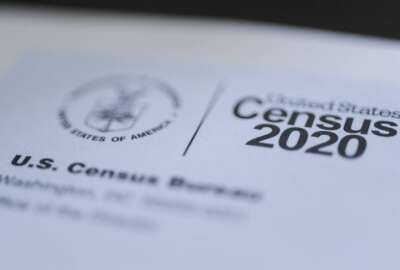Hubbard Radio Washington DC, LLC. All rights reserved. This website is not intended for users located within the European Economic Area.
On Air: Federal News Network
Trending:
Analysis: Pay, benefits, O&M will swallow entire DoD budget by 2024
Absent structural changes, the combination of 10-year budget caps Congress has already approved and rising growth in personnel costs mean DoD would be able to s...
wfedstaff | April 17, 2015 4:51 pm
A new analysis finds that due to the combined effects of capped topline budgets and internal cost growth inside the Pentagon, within the next 10 years, the vast majority of DoD’s budget will be swallowed up by just two budget categories: military personnel and operations and maintenance.
The projections, from the Center for Strategic and Budgetary Assessments, show that given historical trends of cost growth in personnel spending and O&M, those two items will consume 86 percent of the allowed DoD budget by 2021, the year that the spending caps imposed by the 2011 Budget Control Act expire.
Todd Harrison, CSBA’s senior fellow in defense budget studies, said depending on what trajectory those trends in cost growth take, the projections could be even more dire. Over the last 10 years, military personnel and O&M costs have been growing faster than usual: 4.2 percent and 2.7 percent per year, respectively, for every active duty service member.
“To scare you a little more, if the growth rates stay at what they’ve been for the past decade, together, those two accounts will consume the entire defense budget by 2024. You’d have no money left for procurement, for research and development, military construction, for family housing, nothing. Currently, all those other accounts consume about 36 percent of the budget,” Harrison told reporters at a news briefing Friday. “So we’re not on a good path here. DoD’s got to address some of these major structural issues. They’ve got to bend these cost curves significantly.”
More flexibility in future budgets?
DoD could have more flexibility in its spending plans in future years than it does in 2013. Under the budget control act, there are firm top-line budget caps, but the punishing, indiscriminate, program-by-program cuts that are happening this year won’t take place as long as Congress passes budgets that fit within those caps. 
Harrison doesn’t believe that’s a wise bet.
“How realistic do we think it is that the defense budget will have taken a sudden drop in 2013 and then suddenly rise back up in 2014, and somehow these budget caps will magically go away? It just doesn’t seem very likely,” he said. “If you look back at defense spending, at least since the end of World War II, I cannot find a single instance where the budget did something like that, where the base budget dropped 10 percent in one year and then suddenly rose by 10 percent the next year. It just doesn’t happen.”
Harrison said it’s time now for DoD to see the handwriting on the wall and start taking actions to reduce it structural cost growth so in can accommodate what he sees as inevitably lower future budgets. He pointed to three spending categories: military personnel, infrastructure costs and civilian personnel salaries.
With regard to civilian personnel, most of whom are paid with O&M funds, the Pentagon already has more workers than it can afford in the current year under sequestration, so it plans to furlough virtually all of them for approximately 14 work days beginning in June.
“But once we start the new fiscal year on Oct. 1, you’ve still got the same number of civilian personnel on the payroll. If we’re going to stay at those lower budget caps, that’s not affordable. They’re going to have to downsize the force, and it’s time to start planning now,” he said. “That takes time. It’s not the kind of thing you can wait until the start of the fiscal year for. I think it’s something they need to start planning for right now and make some smart, targeted reductions in the civilian workforce to get ahead of this curve.”
DoD would need to cut civilian workforce by 100,000
DoD’s civilian workforce has grown by about 100,000 people over the past decade, and Harrison’s ballpark estimate says the department would need to reduce its headcount by roughly that same number in order to bring its operation and maintenance budget in balance with other needs under the 10-year budget caps.
The department is already undergoing a de facto civilian downsizing by virtue of a hiring freeze that’s been in effect since January, foregoing most of the approximately 1,500-2,000 new hires it brings aboard in a typical week. But that’s not the most elegant way to trim the workforce.
“The problem with a hiring freeze, on top of a pay freeze, on top of a pay cut that everybody’s already taking because of the furloughs, is that they’re not targeted reductions across the force. They’re self-selected reductions. The worst way to downsize your workforce is to put people through something painful and then see who leaves voluntarily,” he said. “The people who are going to leave voluntarily are the people who are more likely to be highly skilled and can find work more easily outside of government. Those are probably the kind of people you want to keep. The people you’re left with are more likely going to be people who don’t think they have good prospects outside the department, or who are close to retirement eligibility and don’t want to lose their benefits by leaving early.”
For military personnel, CSBA’s projections on the crowding out of the budget assume that DoD will not cut end strength any further than it already proposed in last year’s budget, but realistically, Harrison said the military side of the manpower equation will have to shrink as well. But he said it’s vital for DoD to take steps right away to begin to slow the trajectory of the year-over-year increases in the costs it incurs for each uniformed service member.
Ten years ago, DoD spent an average of $70,000 per year on pay and benefits for each soldier, sailor, airman or marine, not counting the cost of benefits paid through other agencies, like education and health programs funded through the Department of Veterans Affairs or tax benefits handled by Treasury. Today, according to CSBA, that number is $110,000, and still growing.
Congress rejected Pentagon plans to control cost growth
While the Pentagon has proposed ways to bring that cost growth under control, they were rejected by Congress. Harrison said that’s because the proposals were politically too tough to swallow — they were all about cutting benefits, not designing a smarter, more cost effective compensation system.
He cited the example of TRICARE for life, a supplemental Medicare benefit Congress mandated in 2001 for military retirees over age 65. To fund payouts for future retirees, DoD has to set aside an average of $5,500 each year for every member of the uniformed services who is currently serving.
“In our study, we went out and surveyed service members, and even if you only look at the people who are virtually guaranteed to get this benefit, they don’t value it as much as $5,500 in cash,” he said. “So why don’t we just give them cash? You could actually give them less cash, pocket the difference, and they’d still be just as happy. So why are we wasting money on forms of compensation that the people who are getting it don’t value?”
Another big contributor to DoD’s overhead expenses is driven by its inventory of military bases. Last year, it asked for permission to undertake another round of base closures through the BRAC process, but there too, Congress said no. Defense officials have signaled they continue to believe the military services have much more infrastructure than can be justified by current military operations and end strength, and plan to continue to ask lawmakers for permission to shed some of that excess real estate.
Harrison said DoD’s last proposal to close bases was not serious, since it proposed no funding to actually implement the BRAC process, but he said further closures are needed nonetheless.
“By DoD’s own estimates, they had 24 percent excess capacity before the last round of base closures. The 2005 round of BRAC only reduced their infrastructure by 3 percent, so they still have 21 percent excess capacity in their bases and facilities. No business in America would be satisfied with operating for a decade with 21 percent more infrastructure than it needed. The problem here is, of course, purely political,” Harrison said.
Ultimately, he said DoD can’t do much of anything to reduce its structural cost drivers without congressional consent. But he said the department needs to start making realistic proposals to lawmakers about what the size and shape of the military could be if the spending caps do stay in place, rather than simply proposing budgets that ignore them.
“Give Congress the plan. Show them, ‘If we’ve got to take this level of cuts, here’s the smartest way we could do it, and here’s the force that would result from that if you give us the flexibility to make some structural reforms.’ Then present an alternative to them: ‘If you don’t give us the flexibility to reform, here’s the best we can do. It will be a smaller, less capable force.’ They need to show Congress the options and make this a fair debate,” he said.
RELATED STORIES:
OMB: Spending bills exceed budget caps, could trigger cuts
DoD in denial about budget future, experts say
Pentagon moving to freeze hiring, delay contracts
Senators cancel reductions to Air National Guard, cut DoD civilians
Panetta throws in the towel on 2013 base closures
Copyright © 2024 Federal News Network. All rights reserved. This website is not intended for users located within the European Economic Area.
Jared Serbu
Jared Serbu is deputy editor of Federal News Network and reports on the Defense Department’s contracting, legislative, workforce and IT issues.
Follow @jserbuWFED





